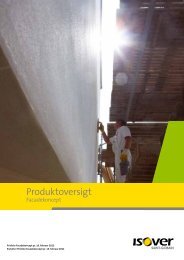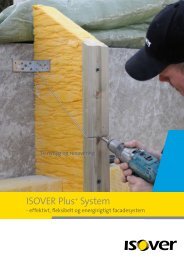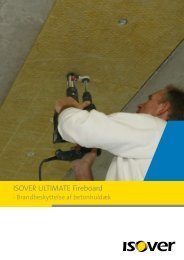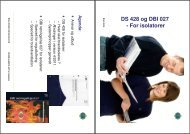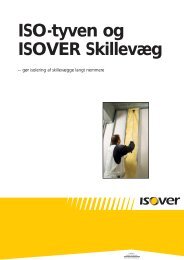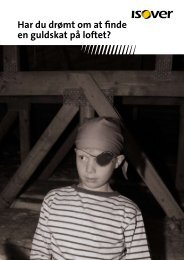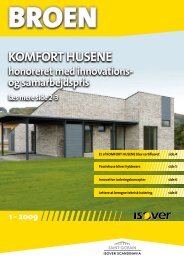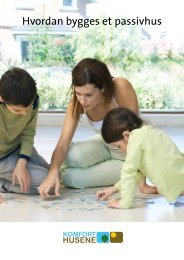SAFE USE INSTRUCTIONS SHEET - Isover
SAFE USE INSTRUCTIONS SHEET - Isover
SAFE USE INSTRUCTIONS SHEET - Isover
You also want an ePaper? Increase the reach of your titles
YUMPU automatically turns print PDFs into web optimized ePapers that Google loves.
8. EXPOSURE CONTROLS / PERSONAL PROTECTIONExposure Limit ValueExposure controls: None at European level.Denmark, limits: 5 mg/m³ for total dust. 1 fibre/ml (respirable): No specific requirementsIndividual protection equipments- Respiratory protection : When working in unventilated area or during operations which can generateemission of any dust, wear disposable face mask. Type in accordance withEN 149 FFP1 is recommended.- Hand protection : Gloves to avoid itching in conformity with EN 388- Eyes protection : Wear goggles when working overhead. Eye protection to EN 166 is advised- Skin protection : Cover exposed skin- Hygiene measures : rinse in cold water before washingThe following sentence and pictograms are printed on packaging
9 PHYSICAL and CHEMICAL PROPERTIESPhysical stateFormColourOdourpHBoiling pointFlash pointFlammabilityExplosive properties: Solid: Roll or panel: Yellow: Light odour may occur: Not applicable: Not relevant: Not relevant: Not relevant: Not relevantDensity : From 10 to 150 kg/m 3Water solubilityFat solubility: Generally chemically inert and insoluble in water.: Not applicableOthers informationApproximate Length weight geometric mean diameter of fibres : 3 à 5 µmLength weight geometric mean diameter less 2 standard errors*: < 6 µmOrientation of fibres: Random*: Regulation (EC) 1272/2008, note R10. STABILITY AND REACTIVITYStabilityDangerous reactions: Stable in normal conditions of use: None in normal conditions of useHazardous decomposition products: None in normal condition of use.11. TOXICOLOGICAL INFORMATIONAcute effect: The mechanical effect of fibres in contact with the skin can cause a temporary itching.12. ECOLOGICAL INFORMATIONThis product is not expected to cause harm to animals or plants during normal conditions of use.13. DISPOSAL CONSIDERATIONSWaste from residuesDirty packaging: Dispose of in accordance with regulations and procedures in force incountry of use or disposal.: Dispose of in accordance with local regulations.Code from European Waste Catalogue : 17 06 04
14. TRANSPORT INFORMATIONInternational regulations: No specific regulations15. REGULATORY INFORMATIONThe European directive 97/69/EC replaced by the regulation (EC) n° 1272/2008 concerning the classification, labellingand packaging of the substance and the mixtures does not classify glass fibres as hazardous, if they are in compliancewith the note Q of this Regulation.The note Q specifies that classification as carcinogenic does not apply if:- a short-term biopersistence test by inhalation has shown that fibres longer than 20µm have a weight half life less than10 days, or- a short-term biopersistence test intra-tracheal instillation has shown fibres longer than 20 µm have a weighted half lifeless than 40 days, or- an appropriate intra-peritoneal test has shown no evidence of excess carcinogenicity, or- a suitable long term inhalation test has shown absence of relevant pathogenicity or neoplastic changes.Mineral wool (glass, stone and slag wool) are not classified under the European Regulation on classification, labellingand packaging of substances and mixtures (“CLP” Regulation – Regulation EC n° 1272/2008) which is the Europeanimplementation of the international Globally Harmonized System (“GHS”)16. OTHER INFORMATIONThe glass wool fibres of this product are exonerated from the carcinogenic classification according to the Europeandirective 97/69/CE and the Regulation (EC) 1272/2008 if they fulfil one of the criteria of the nota Q of these texts.All products manufactured by Saint-Gobain ISOVER A/S are made of non-classified fibres and are certified by EUCEB.EUCEB, European Certification Board of Mineral Wool Products - www.euceb.org, is a voluntary initiative by the mineralwool industry. It is an independent certification authority that guarantees that products are made of fibres, which complywith the exoneration criteria for carcinogenicity (Note Q) of the Directive 97/69/EC and the Regulation (EC) 1272/2008.To ensure that fibres comply with the exoneration criteria all tests and supervision procedures are carried out byindependent, expert qualified institutions. EUCEB ensures that the producers of mineral wool have put in place selfcontrolmeasures.The mineral wool producers commit to EUCEB to:• supply sampling and analysis reports established by laboratories recognized by EUCEB, proving that the fibrescomply with one of the four criteria of exoneration described in Note Q of the Directive 97/99/EC,• be controlled, twice per year, of each production unit by an independent third party recognized by EUCEB(sampling and conformity to the initial chemical composition),• put in place procedures of internal self-control in each production unit.The products responding to the EUCEB certification are recognized by the EUCEB logo put on the packaging.EUCEB is an ISO 9001:2000 certified association.Moreover, in 2001, the International Agency for Research on Cancer, re-evaluated and reclassified mineral wool(insulation glass wool, rock(stone) wool and slag wool) from Group 2B (possibly carcinogenic) to Group 3 « agent whichcannot be classified as for their carcinogenicity to humans». (See Monograph Vol 81, http://monographs.iarc.fr/)Person who wish to obtain more detailed information have to contact the producer (address on the first page of thissheet).Information given in this document is on the state of our knowledge regarding this material as of December 4 th , 2012.It is given in good faith.The attention of users is drawn to possible risks taken when the product is used for other application than the ones ithas been designed for.



